
Consumers see seafood as a luxury item, but that’s not a good portrayal at a time when budgets are tight and shoppers are worried about inflation.
“The problem isn’t the fish,” said Jeremy Woodrow, executive director of the Alaska Seafood Marketing Association. “The challenge is in the global market.”
Woodrow in February described the 2023 Alaska salmon market as “rock bottom” due to falling prices and sluggish demand, but said at the time that the industry may be coming out of the bottom.
Now, as the summer season gets underway, “a lot of people in the industry are optimistic,” he said on Friday, June 14.
At least the market is “not worsening,” he added.
Still, the pain is not going away. “A lot of our buyers are just hanging on,” Woodrow said. “Our processors have lost a lot of money in the last year or two.”
Shoppers’ tight budgets remain an issue, he said, and “consumers still view seafood as a luxury item.”
Last year’s market was so bad that some processors were paying as little as 20 cents per pound of sweet potatoes, and others stopped buying early.
Jeff Welborn, senior vice president of Alaska operations for Trident Seafoods, said last year was “a year we don’t want to repeat.”
“I think the situation is certainly stabilizing,” he said last week about his outlook for this summer.
Woodrow said last year’s stocks of Alaska salmon in warehouses have “mostly moved on,” opening the market for this summer’s catch. But unlike past years, “we’re not seeing big preseason commitments” from buyers to ease anxiety and financial strain on processors.
“That creates some challenges,” Woodrow said, putting processors at risk of freezing or canning more fish than the market will buy in a timely manner.
But he said there are some bright spots heading into the summer.
Preseason base prices in Bristol Bay, the state’s largest sockeye salmon fishery, are about 80 cents per pound, about 20 cents higher than last year but still far below the $1.15 in 2022, $1.25 in 2021 and $1.35 in 2019.
The state also is forecasting a near-normal pink salmon catch in Southeast Alaska, less than half of last year’s. “A near-normal catch helps the industry correct itself,” Woodrow said of matching supply and demand.
He said blanket U.S. sanctions on Russian seafood imports that took effect last month will help Alaska products become more competitive in the domestic market, as Russia floods global markets with low-priced seafood to boost its revenues.
The ban on Russian seafood imports into the U.S. began in 2022, but Russia had been getting around it by sending fish and crab to other countries for processing and then exporting to the U.S. The full import ban ends that practice.
But Russia still offloads fish to other parts of the world at extremely low prices, Woodrow said. The ban only applies to the U.S. market, where 30 percent of Alaska seafood is sold, leaving the other 70 percent of Alaska seafood still subject to competition from Russia.

